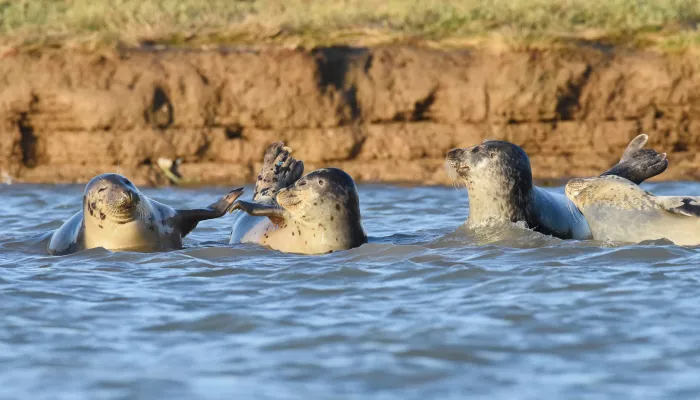Bryony Chapman, Marine Policy Officer at Kent Wildlife Trust said: “We are delighted to see The Swale Estuary, Dover to Deal and Dover to Folkestone MCZs being put forward for possible designation this year. However, with only 23 out of the 37 candidate sites included in the consultation, we are dismayed at the lack of ambition shown by the Government to complete the long-promised national network.”
She continued: “We are urging members of the public to have their say and respond to the consultation, and tell the Government that they care about these wonderful Kent sites and want to see them protected - we cannot afford to lose these as well from lack of support during this consultation! Just as importantly, these local sites cannot operate properly in isolation - they need to be part of a wider network of protected areas to help our seas recover.”
Joan Edwards, The Wildlife Trusts’ Head of Living Seas, said: “We are bitterly disappointed that the Government has opted to consult on just 23 new Marine Conservation Zones and that some very important areas for marine wildlife have been dropped from the list. We are particularly frustrated that a number of sites - including in the Irish Sea - have been removed because of the likely ‘economic cost’.
“The Wildlife Trusts believe this is a missed opportunity to achieve longer-term gains that will benefit marine biodiversity and fishing. Ultimately an economic activity that is based on over-exploitation, beyond the ability of the resource to renew itself, is not sustainable and has no long-term future.”
Kent Wildlife Trust’s Bryony Chapman continued: “We are hugely concerned about the Government’s failure to include sites in the Irish Sea, leaving it open to environmental disaster. Supporting sustainable fisheries, instead of encouraging overfishing and habitat destruction, would increase fish landings, generate more income and create more jobs in the sector. Decision-makers need to think of sustainable fisheries as an opportunity for job creation and increasing the value of fisheries rather than an environmental principal that comes at a price to the industry. Marine Conservation Zones are a vital part of this process.”
Joan Edwards explains: “Only this week, the Government’s Natural Capital Committee published a report which shows that investment in nature makes obvious economic sense. The Government must develop a comprehensive strategy to secure the recovery of nature in a generation. This must include the designation of a well-managed and ecologically coherent network of Marine Protected Areas.”
Kent Wildlife Trust will be working with Wildlife Trust colleagues across the country to respond in detail to the Government consultation. It will be providing background information on its website shortly, and urging members of the public to sign up to the MCZ Friends campaign in the meantime at www.wildlifetrusts.org/MCZfriends
Marine Conservation Zones protect threatened undersea habitats such as eelgrass meadows, rocky reefs and deep-water canyons – and the animals that live in and around them. These important sanctuaries for marine life remain at risk until more areas offering effective protection are established. Marine Conservation Zones should protect the species and habitats found within them from the most damaging and degrading of activities such as scallop dredging and trawling, whilst mostly allowing sustainable activity to continue.
Of the 37 sites listed below, 23 (shown in bold black) are now included in the current Marine Conservation Zones consultation, which runs for 12 weeks from Friday 30th January, ending Friday 24th April 2015:
Region | 23 Candidate Sites included in the consultation for possible 2015 designation: | 14 Candidate sites removed from the list for 2015 designation: |
| SE England | Swale Estuary Dover to Deal Dover to Folkestone Offshore Brighton Offshore Overfalls Utopia The Needles | Bembridge Norris to Ryde Yarmouth to Cowes |
| SW England | Western Channel Mounts Bay Lands End North-West of Jones Bank Greater Haig Fras Newquay and the Gannel Hartland Point to Tintagel Bideford to Foreland Point | Studland Bay North of Lundy |
| Irish Sea | West of Walney Allonby Bay | South of Celtic Deep Celtic Deep East of Celtic Deep Mid St George's Channel North St George's Channel Slieve Na Griddle South Rigg Mud Hole |
| North Sea | Coquet to St Mary's Farnes's East Fulmar Runswick Bay Holderness Inshore Cromer Shoal Chalk Beds | Compass Rose |
The centre-piece of the landmark Marine & Coastal Access Act (2009) legislation was the commitment to establish a network of Marine Protected Areas throughout UK seas; a response to the widely acknowledged crisis facing the health, diversity and productivity of our seas. While this Parliament has seen the first designations, we remain a long way from the full network.
127 recommended Marine Conservation Zones were chosen after two years of hard work by more than one million stakeholders from all sectors of the marine environment and at a cost of over £8.8 million to Government. 27 Marine Conservation Zones were designated in November 2013 as a first step towards achieving an ecologically coherent network of areas which will protect and help to restore the marine environment.
In February 2014, Defra released a list of 37 sites, recommended by experts and stakeholders, to be considered for a second tranche of Marine Conservation Zones. The excluded areas were identified by the statutory nature advisors as necessary to help fill current gaps in the network of protected areas at sea and achieve ecological coherence. The Government is committed to a third tranche, to complete the network, by 2016.

